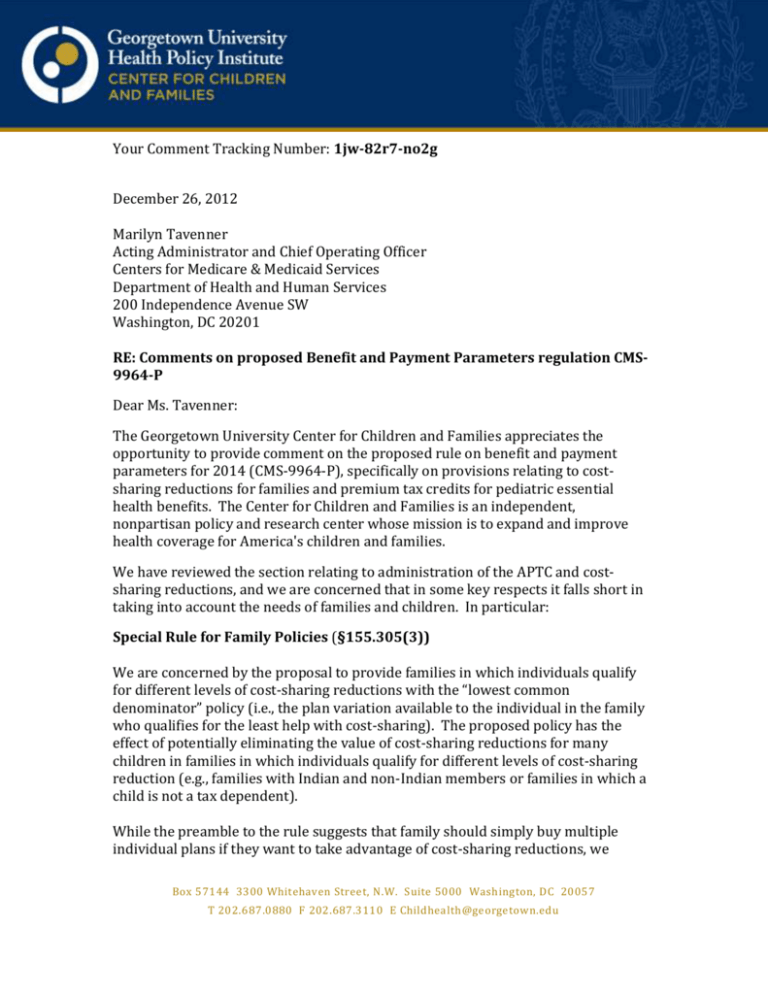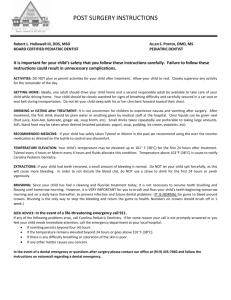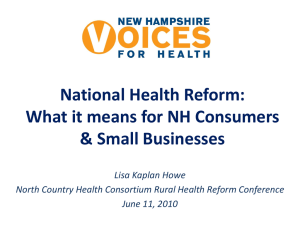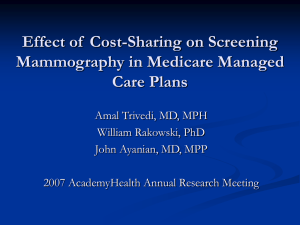CCF Comments - Center For Children and Families
advertisement

Your Comment Tracking Number: 1jw-82r7-no2g December 26, 2012 Marilyn Tavenner Acting Administrator and Chief Operating Officer Centers for Medicare & Medicaid Services Department of Health and Human Services 200 Independence Avenue SW Washington, DC 20201 RE: Comments on proposed Benefit and Payment Parameters regulation CMS9964-P Dear Ms. Tavenner: The Georgetown University Center for Children and Families appreciates the opportunity to provide comment on the proposed rule on benefit and payment parameters for 2014 (CMS-9964-P), specifically on provisions relating to costsharing reductions for families and premium tax credits for pediatric essential health benefits. The Center for Children and Families is an independent, nonpartisan policy and research center whose mission is to expand and improve health coverage for America's children and families. We have reviewed the section relating to administration of the APTC and costsharing reductions, and we are concerned that in some key respects it falls short in taking into account the needs of families and children. In particular: Special Rule for Family Policies (§155.305(3)) We are concerned by the proposal to provide families in which individuals qualify for different levels of cost-sharing reductions with the “lowest common denominator” policy (i.e., the plan variation available to the individual in the family who qualifies for the least help with cost-sharing). The proposed policy has the effect of potentially eliminating the value of cost-sharing reductions for many children in families in which individuals qualify for different levels of cost-sharing reduction (e.g., families with Indian and non-Indian members or families in which a child is not a tax dependent). While the preamble to the rule suggests that family should simply buy multiple individual plans if they want to take advantage of cost-sharing reductions, we Box 57144 3300 Whitehaven Street, N.W. Suite 5000 Washington, DC 20057 T 202.687.0880 F 202.687.3110 E Childhealth@georgetown.edu disagree that such an option is viable for many families. To the contrary, it seems unrealistic to expect families to purchase multiple individual policies, as well as to expect Exchanges to be able to simply and coherently explain to consumers the advantages and disadvantages of buying multiple individual policies versus a family policy. Moreover, some of the cost-sharing protections (e.g., out of pocket maximums) are family-based protections that will be undercut if individuals must purchase separate policies. For example, a family that buys two individual policies – rather than a single family policy – would face two different out-of-pocket maximums rather than a single, unified family-based maximum on out-of-pocket expenses. We recommend that HHS pursue alternative options. For example, it could require issuers to provide a family-based plan that offers a weighted actuarial value, reflecting the cost-sharing reductions available to individual members. While such an approach may indeed be challenging for issuers to implement, individuals will have an even harder time navigating the complexity that would be created by a policy that forced them to choose multiple individual policies rather than familybased coverage if they need extra help with cost-sharing charges. §155.340 Administration of advance payments of the premium tax credit and cost-sharing reductions. We are concerned that §155.340 appears to assume that families will not receive any help via APTCs in purchasing separate dental-only coverage for their children unless they happen to have “residual” APTCs after paying their health care premiums. We strongly believe that Congress intended to provide low and moderate-income families extra help in purchasing coverage for their children that includes pediatric dental coverage. As HHS has acknowledged in various contexts, pediatric dental coverage clearly is considered part of the essential health benefit. Moreover, the statutory language of the ACA indicates that Congress intended for the cost of pediatric dental coverage secured through a stand-alone plan to be considered when calculating the size of an APTC. Specifically, ACA section 1401(a) added IRC section 36B(b)(3)(E), which reads: ‘‘(E) SPECIAL RULE FOR PEDIATRIC DENTAL COVERAGE.—For purposes of determining the amount of any monthly premium (emphasis added), if an individual enrolls in both a qualified health plan and a plan described in section 1311(d)(2)(B)(ii)(I) of the Patient Protection and Affordable Care Act for any plan year, the portion of the premium for the plan described in such section that (under regulations prescribed by the Secretary) is properly allocable to pediatric dental benefits which are included in the essential health benefits required to be provided by a qualified health plan under section 1302(b)(1)(J) of such Act shall be treated as a premium payable for a qualified health plan.” While §155.340 is concerned only with the administration of the APTCs, we believe it nevertheless should be modified to indicate that families can receive an APTC that 2 reflects the cost of purchasing pediatric dental coverage through a separate, dentalonly plan. (In our comments on other rules, including the proposed rule on Essential Health Benefits (CMS-9980-P), we identify additional specific changes that should be made to clarify that the cost of pediatric dental coverage secured through a stand alone dental plan is included when calculating the size of a family’s APTC). Thank your for considering our comments. Any questions on these comments may be directed to Jocelyn Guyer, Co-Executive Director, at jag99@georgetown.edu or 202-784-4077. Sincerely, Georgetown University Center for Children and Families. 3






